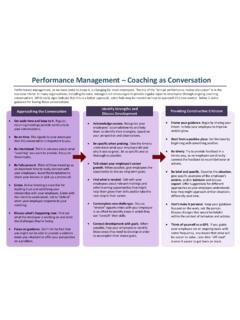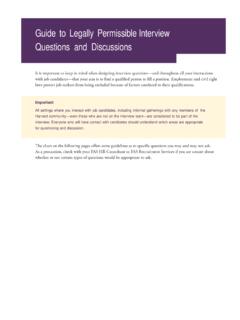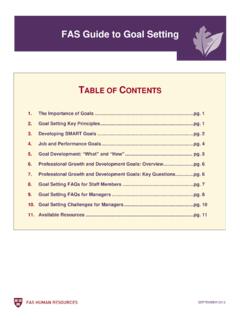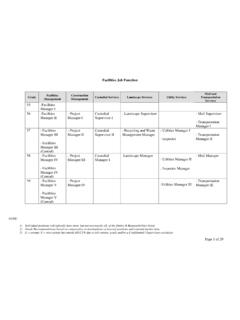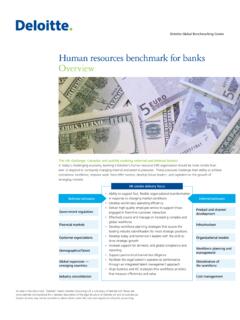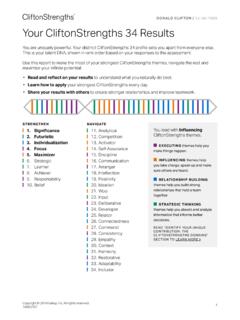Transcription of Managers’ Talking Points and Scripts
1 April 2014 1 Managers Talking Points and Scripts Differentiating Performance and Linking Pay to Performance Differentiating Performance at the FAS 1. Our Goal To help FAS managers conduct meaningful performance conversations, and to provide performance reviews for all FAS staff which take into account different levels of performance. These materials are intended to help managers plan for potentially challenging conversations with their staff which involve differentiating performance or linking pay to performance. 2. Why Differentiating Performance is Important Meaningful performance reviews help FAS staff members to understand what is expected of them, what they are doing well, and where they need to develop. This understanding increases our effectiveness as an institution and engages employees in their work.
2 As an academic institution, our FAS faculty members assess their students in an effort to recognize their achievements. Similarly, as managers we aim to recognize the accomplishments of our staff and to provide candid feedback regarding performance in a given year. FAS employees tell us that performance feedback from their managers has helped them to understand how well they are doing in their current role and how to improve (if applicable), thus strengthening staff performance across FAS. Last year, 42% of FAS staff who received a performance assessment were identified as having leading performance. This means that FAS managers indicated that almost half of their staff members performance was consistently superior and far exceeded expectations and consistently exhibited the highest performance in all job capabilities.
3 Having nearly half of reviewed staff assessed as leading leaves less room to recognize this type of performance and does not provide realistic feedback to our staff on how they could develop to achieve even greater results. Several large FAS divisions are already differentiating performance, including Athletics, Administration and Finance, Admissions and Financial Aid, the FAS Dean s Office, and Harvard College Library and we continue to move in this direction. 23. What this Means for You as a Manager and for your Staff Performance differentiation enables managers to appropriately reward their top performers, to support good performers in improving their skills and their results, and to address low performers. These efforts make FAS a stronger organization and enable us to meet our teaching and research mission more effectively.
4 FAS is committed to continuing to make progress in this effort. At the FAS, there is a baseline expectation that staff members will perform at a solid level (consistently demonstrates effective performance. Someone who gets the job done and effectively prioritizes work). Some employees will exceed those expectations, while others may not. Managers are asked to differentiate employees performance so that only those employees whose performance contributions have tremendous and consistently positive impact and value to the department and are easily recognized as a top performer compared to peers are assessed as leading performers. 4. Performance Rating Scale Rating Definition Leading Performance Contributions have tremendous and consistently positive impact and value to the department and or the organization.
5 May be unique, often one-time achievements that measurably improve progress towards organizational goals. Easily recognized as a top performer compared to peers. Viewed as an excellent resource for providing training, guidance, and support to others. Demonstrates high-level capabilities and proactively takes on higher levels of responsibility. Strong Performance Consistently demonstrates high level of performance. Consistently works toward overall objectives of the department and or organization. Viewed as a role model in position. Demonstrates high levels of effort, effectiveness, and judgment with limited or no supervision. Solid Performance Consistently demonstrates effective performance. Performance is reflective of a fully qualified and experienced individual in this position.
6 Viewed as someone who gets the job done and effectively prioritizes work. Contributes to the overall objectives of the department and or the organization. Achieves valuable accomplishments in several critical areas of the job. Building Performance Working toward gaining proficiency. Demonstrates satisfactory performance inconsistently. Achieves some but not all goals and is acquiring necessary knowledge and skills. For new employees: this rating can be used when an employee is still coming up to speed with their job duties as appropriate, based on their tenure in the position. Not Meeting Expectations The quality of performance is inadequate and shows little or no improvement. Knowledge, skills, and abilities have not been demonstrated at appropriate levels. 35. How to Approach Differentiating Performance: Leading, Strong, and Solid No performance management system is perfect.
7 Effectiveness comes from the way that we, as managers, conduct performance management and communicate with employees. While communicating these messages is challenging for everyone, we ll get better at it the more we plan for them and practice them in advance. Fairly and accurately differentiating performance may call for a candid and possibly challenging conversation with any staff member whom you assess as strong or solid rather than leading , particularly if s/he assesses her/himself in this way. While we recognize that not everyone exhibits leading performance, some employees may feel devalued if they are assessed as solid or even as strong . It is important to set expectations for staff that a solid assessment is the starting expectation for day-to-day performance of Harvard staff and is a very good assessment, and that a strong assessment is excellent.
8 Most importantly, as a manager, help your employee (whom you are assessing as strong ) to understand how s/he can work toward achieving a leading assessment for next year. In other words, describe the behaviors and actions that the employee could take to close the gap between a strong assessment and a leading assessment. Likewise, you may wish to identify specific, measurable goals that would help your solid staff to achieve a strong assessment during FY 2015. In situations where managers are responsible for a small, high-performing group (four or fewer staff members), we recognize that there may be additional challenges in differentiating performance and we will need to be flexible. your HR Consultant can help you in these situations. 6. Differentiating Performance: Building Performance vs.
9 Not Meeting Expectations Building Performance is the category for employees who achieve some, but not all, of their goals. They need to work toward gaining proficiency and/or to acquire necessary knowledge and skills in order to meet all job responsibilities. For new employees, this rating can be used when an employee is still coming up to speed with their job duties as appropriate, based on their tenure in the position. Not Meeting Expectations is the category for those who have been in their current position for a year or more without demonstrating the needed skills and knowledge to perform at a satisfactory level, and those whose quality of performance is inadequate and shows little or no improvement. These employees should be moving toward progressive discipline, or in progressive discipline.
10 7. A Note about Faculty Managers Faculty managers may be inclined to assess their strong or solid staff members as leading because they do a very good job on their behalf. Often, a faculty assistant is the faculty manager s only direct report. If possible, try to help faculty managers understand that his/her faculty assistant supports other colleagues (including other faculty members), some of whom may have very different views of the employee s performance. 4 Linking Pay to Performance 1. Eligible Audience Linking pay to performance applies only to benefits-eligible, exempt staff and non-HUCTW, non-exempt staff hired on or before April 1, 2014. HUCTW staff members salary increases are determined by the University and HUCTW. 2. Why Linking Pay to Performance is Important Linking pay to performance within the FAS is something that FAS employees have consistently requested.
